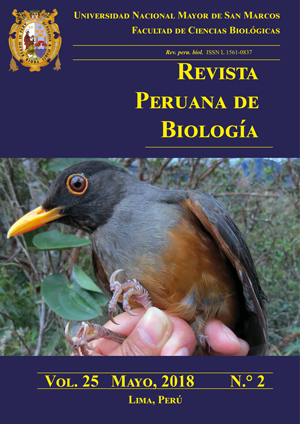Normal, and lognormal: two frequency distributions, and one Unified Neutral Theory for studying Tropical forests
DOI:
https://doi.org/10.15381/rpb.v25i2.14690Keywords:
Biodiversity surveys, Central limit theorem, Random sampling, Relative abundances.Abstract
Biodiversity surveys among contrasting sites get normal, and lognormal distributed data used for quantifying how Climate Change affects forests around the world. Yet most biologists are familiarized with the normal distribution, while few discuss why the lognormal distribution of relative frequencies of species is so common in many communities of living beings. We aim to add more researchers into such a discussion. Both normal and lognormal have mean and extreme values –which is consistent with the Central Limit Theorem. Such a theorem is valid when the data come from random processes, and when the sampling excercise of collecting the data has been stocastic and representative. According to Steve Hubbell’s Unified Neutral Theory of Biodiversity and Biogeography, random birth, death, migration and speciation in a community –and from the surrounding metacomunity are enough for generating lognormal distributions of relative frequencies of co-existing species. That is consistent with Island Biogography, and is applicable to the assembly of relative abundances of tree species during secondary succession, where the clear-cut site is an island further colonized by tree species. Deep into the sophisticated 21st century, simple numerical knowledge like the normal and lognormal are still needed for moving the borders of science by facing permanent subjects: why in so many places some species are more abundant than others, and how to tackle the loss of endangered species.Downloads
Downloads
Published
Issue
Section
License
Copyright (c) 2018 Edgardo I. Garrido-Pérez, Laura González, Jairo Cabrera, Jamil Rojas-Salvatierra, María I. Arias-Pizarro, Mathew Tello

This work is licensed under a Creative Commons Attribution-NonCommercial-ShareAlike 4.0 International License.
AUTHORS RETAIN THEIR RIGHTS:
a. Authors retain their trade mark rights and patent, and also on any process or procedure described in the article.
b. Authors retain their right to share, copy, distribute, perform and publicly communicate their article (eg, to place their article in an institutional repository or publish it in a book), with an acknowledgment of its initial publication in the Revista Peruana de Biologia.
c. Authors retain theirs right to make a subsequent publication of their work, to use the article or any part thereof (eg a compilation of his papers, lecture notes, thesis, or a book), always indicating its initial publication in the Revista Peruana de Biologia (the originator of the work, journal, volume, number and date).


















